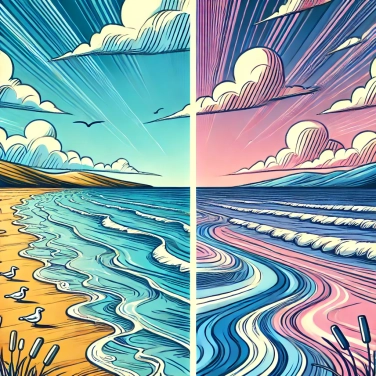High and low tides occur every day due to the gravitational attraction exerted by the Moon and the Sun on the oceans. This phenomenon is caused by the gravitational force and the centrifugal force, which create ripples in the water and thus cause the tides.

The Moon attracts the oceans thanks to its gravitational pull. Since water is fluid, it easily responds to this force, thus creating a sort of "bulge" of water oriented towards the Moon. This bulge is what we call high tide. On the opposite side of the Earth, another bulge forms because the Moon attracts the solid center of the Earth more, leaving the water "behind." This results in two bulges of water at the same time: one on the side of the Moon and one on the opposite side. As the Earth rotates on its axis, these two bulges seem to move relative to us, thereby generating the regular cycles of high and low tides each day.
Even though the Moon plays the leading role in tides, the Sun also has a say. Indeed, the Sun is far more massive, but since it is significantly farther away than the Moon, its attraction on the oceans is roughly half as strong. Specifically, it either enhances or diminishes the lunar effects depending on its position relative to the Earth and the Moon. When the Earth, Moon, and Sun align approximately in a straight line (during full and new moons), the solar attraction cooperates with the Moon, creating particularly strong tides known as spring tides. Conversely, when the Sun and Moon form a right angle with the Earth, their effects somewhat counteract each other, resulting in more moderate tides called neap tides. In short, the Sun is not the main star here, but certainly not just a background character either!
Every day, most places experience two high tides and two low tides. Why two? Because as the Earth rotates on its axis over 24 hours, each point on the planet passes through the ocean "bulges" created mainly by the attraction of the Moon twice. Once on the side facing the Moon, where the water is drawn towards it, and once on the opposite side, where inertia creates a second bulge. Between these two passages, about six hours apart, are the low tides, when we find ourselves in the troughs where the sea recedes. These cycles are predictable, but the height of the tides can vary according to the position of the Sun, the Moon, as well as the local geography of the coasts.
When the Earth, the Moon, and the Sun are aligned, their gravitational forces work together: this is referred to as spring tides. This occurs during each full moon or new moon, resulting in particularly strong high tides and very pronounced low tides. Conversely, when these three celestial bodies form a right angle, their gravitational forces partially counteract each other, reducing the amplitude of the tides: these are called neap tides. Neap tides occur during the first and last quarters of the moon, making the tides much less impressive. This entire ballet among the celestial bodies not only determines the strength but also the variable rhythm of the tides each day.
A complete tide, which includes a high tide and a low tide, lasts about 12 hours and 25 minutes, explaining why the timing of the tides shifts each day by approximately 50 minutes.
When the Sun, the Earth, and the Moon are perfectly aligned during the full moon and new moon phases, we observe what are called 'spring tides,' characterized by the highest amplitudes.
Tides are not limited to the oceans. The Earth's solid crust also experiences the effects of terrestrial tides, rising and falling subtly on a daily basis.
The Moon is slowly drifting away from the Earth at a rate of about 3.8 cm per year, resulting in a very slight increase in the length of the Earth's day over millions of years.

80% of respondents passed this quiz completely!
Question 1/5